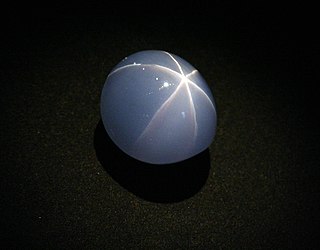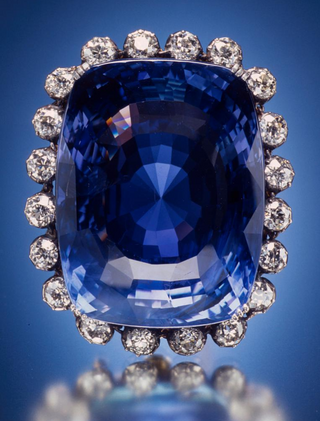
Sapphire is a precious gemstone, a variety of the mineral corundum, consisting of aluminium oxide (α-Al2O3) with trace amounts of elements such as iron, titanium, cobalt, lead, chromium, vanadium, magnesium, boron, and silicon. The name sapphire is derived via the Latin sapphirus from the Greek sappheiros (σάπφειρος), which referred to lapis lazuli. It is typically blue, but natural "fancy" sapphires also occur in yellow, purple, orange, and green colors; "parti sapphires" show two or more colors. Red corundum stones also occur, but are called rubies rather than sapphires. Pink-colored corundum may be classified either as ruby or sapphire depending on locale. Commonly, natural sapphires are cut and polished into gemstones and worn in jewelry. They also may be created synthetically in laboratories for industrial or decorative purposes in large crystal boules. Because of the remarkable hardness of sapphires – 9 on the Mohs scale (the third hardest mineral, after diamond at 10 and moissanite at 9.5) – sapphires are also used in some non-ornamental applications, such as infrared optical components, high-durability windows, wristwatch crystals and movement bearings, and very thin electronic wafers, which are used as the insulating substrates of special-purpose solid-state electronics such as integrated circuits and GaN-based blue LEDs. Sapphire is the birthstone for September and the gem of the 45th anniversary. A sapphire jubilee occurs after 65 years.

A ruby is a pinkish red to blood-red colored gemstone, a variety of the mineral corundum. Ruby is one of the most popular traditional jewelry gems and is very durable. Other varieties of gem-quality corundum are called sapphires. Ruby is one of the traditional cardinal gems, alongside amethyst, sapphire, emerald, and diamond. The word ruby comes from ruber, Latin for red. The color of a ruby is due to the element chromium.

The Hope Diamond is a 45.52 carats diamond extracted in the 17th century from the Kollur Mine in Guntur, India. It is blue in color due to trace amounts of boron. Its exceptional size has revealed new information about the formation of diamonds.

The Cullinan Diamond is the largest gem-quality rough diamond ever found, weighing 3,106 carats (621.20 g), discovered at the Premier No.2 mine in Cullinan, South Africa, on 26 January 1905. It was named after Thomas Cullinan, the owner of the mine. In April 1905, it was put on sale in London, but despite considerable interest, it was still unsold after two years. In 1907, the Transvaal Colony government bought the Cullinan and Prime Minister Louis Botha presented it to Edward VII, the British king who reigned over the territory, and it was cut by Joseph Asscher & Co. in Amsterdam.

The Star of India is a 563.35-carat star sapphire, one of the largest such gems in the world. It is almost flawless and is unusual in that it has stars on both sides of the stone. The greyish-blue gem was mined in Sri Lanka and is housed in the American Museum of Natural History in New York City.

A chemically pure and structurally perfect diamond is perfectly transparent with no hue, or color. However, in reality almost no gem-sized natural diamonds are absolutely perfect. The color of a diamond may be affected by chemical impurities and/or structural defects in the crystal lattice. Depending on the hue and intensity of a diamond's coloration, a diamond's color can either detract from or enhance its value. For example, most white diamonds are discounted in price when more yellow hue is detectable, while intense pink diamonds or blue diamonds can be dramatically more valuable. Of all colored diamonds, red diamonds are the rarest. The Aurora Pyramid of Hope displays a spectacular array of naturally colored diamonds, including red diamonds.

The Iranian National Jewels, originally the Iranian Crown Jewels, include elaborate crowns, thirty tiaras, and numerous aigrettes, a dozen bejeweled swords and shields, a number of unset precious gems, numerous plates and other dining services cast in precious metals and encrusted with gems, and several other more unusual items collected or worn by the Persian monarchs from the 16th century and on. The collection is housed at the Treasury of National Jewels, situated inside the Central Bank of Iran on Tehran's Ferdowsi Street.

The Logan Sapphire is a 422.98-carat (84.596 g) sapphire from Sri Lanka. One of the largest blue faceted sapphires in the world, it was owned by Sir Victor Sassoon and then purchased by M. Robert Guggenheim as a gift for his wife, Rebecca Pollard Guggenheim, who donated the sapphire to the Smithsonian Institution in 1960. The sapphire's name is derived from Rebecca's new surname after marrying John A. Logan. It has been displayed in the National Gem Collection of the National Museum of Natural History in Washington, D.C., since 1971. It is a mixed cushion-cut sapphire, approximately the size of a large chicken egg, and set in a silver and gold brooch surrounded by 20 round brilliant-cut diamonds.

Harry Winston was an American jeweler. He donated the Hope Diamond to the Smithsonian Institution in 1958 after owning it for a decade. He also traded the Portuguese Diamond to the Smithsonian in 1963 in exchange for 3,800 carats of small diamonds.
The Ruspoli Sapphire, also known as the Wooden Spoon Seller's Sapphire, is a 136.9 carat blue sapphire that has historically been confused with Grand Sapphire of Louis XIV. Recent research has shown that not only are these two separate gems, but also that the story of once being owned by the Ruspoli family and having been acquired from a wooden spoon seller in Bengal are both apocryphal tales with no basis. The origins of this confusion stem from a book published in 1858 by Charles Barbot, who confused the Ruspoli Sapphire with the Grand Sapphire of Louis XIV.
The Taylor–Burton Diamond, a diamond weighing 68 carats (13.6 g), became famous in 1969 when it was purchased by actors Richard Burton and Elizabeth Taylor. Burton had previously been the underbidder when jeweller Cartier bought the diamond at auction for $1,050,000, setting a record price for a publicly sold jewel. Thousands of people in New York and Chicago queued to see the diamond after its 1969 sale. It was subsequently worn by Taylor at Princess Grace of Monaco's 40th birthday, and at the 42nd Academy Awards.

The Wittelsbach-Graff Diamond is a 31.06-carat (6.212 g) deep-blue diamond with internally flawless clarity, originating in the Kollur Mine, India. Laurence Graff purchased the Wittelsbach Diamond in 2008 for £16.4 million. In 2010, Graff revealed he had had the diamond cut by three diamond cutters to remove flaws. The diamond was now more than 4 carats (800 mg) lighter and was renamed the Wittelsbach-Graff Diamond. There is controversy, as critics claim the recutting has so altered the diamond as to make it unrecognisable, compromising its historical integrity.

The Patiala Necklace was a necklace designed and made by Cartier in 1928. It was part of the largest ever single order to Cartier to date, made in 1925 by the Indian royalty, the Maharaja of Patiala, for the Patiala Necklace and other jewelry worth ₹1,000 million.

Yogo sapphires are blue sapphires, a colored variety of corundum, found in Montana, primarily in Yogo Gulch in Judith Basin County, Montana. Yogo sapphires are typically cornflower blue, a result of trace amounts of iron and titanium. They have high uniform clarity and maintain their brilliance under artificial light. Because Yogo sapphires occur within a vertically dipping resistive igneous dike, mining efforts have been sporadic and rarely profitable. It is estimated that at least 28 million carats of Yogo sapphires are still in the ground. Jewelry containing Yogo sapphires was given to First Ladies Florence Harding and Bess Truman; in addition, many gems were sold in Europe, though promoters' claims that Yogo sapphires are in the crown jewels of England or the engagement ring of Princess Diana are dubious. Today, several Yogo sapphires are part of the Smithsonian Institution's gem collection.
The Archduke Joseph is a colorless, antique cushion-shaped brilliant, originally weighing 78.54 carat, purchased by Molina Jewelers of Arizona sometime in the late-1990s and slightly re-cut to 76.45 carat to improve clarity and symmetry. It is, on the Gemological Institute of America (GIA) color and clarity scales, a D grade, IF diamond and the largest DIF ever graded at the GIA; and it is of type IIa.

The Sunrise Ruby is the world's most expensive ruby, most expensive coloured gemstone, and most expensive gemstone other than a diamond.

Golconda diamonds are mined in the Godavari delta region of the present-day states Andhra Pradesh and Telangana, India. Golconda Fort in the western part of modern-day Hyderabad was a seat of the Golconda Sultanate and became an important centre for diamond enhancement, lapidary, and trading. Golconda diamonds are graded as Type IIa, are formed of pure carbon, are devoid of nitrogen, and are large with high clarity. They are often described as diamonds of the first water, making them among history's most-celebrated diamonds. The phrase "Golconda diamond" became synonymous with diamonds of incomparable quality.
The Red Cross Diamond is a canary-yellow 205.07-carat, cushion-shaped cut diamond which is among the largest known cut diamonds. The diamond was auctioned off in 1918 to support the British Red Cross Society. It has a Maltese cross visible in the diamond.

The Queen Marie of Romania Sapphire is a 478.68 carat Cornflower blue cushion cut Ceylon sapphire. When it was sold at Christie's in 2003, it was the largest sapphire ever offered at auction. It is named for its association with its first owner, Marie of Edinburgh, Queen of Romania.















